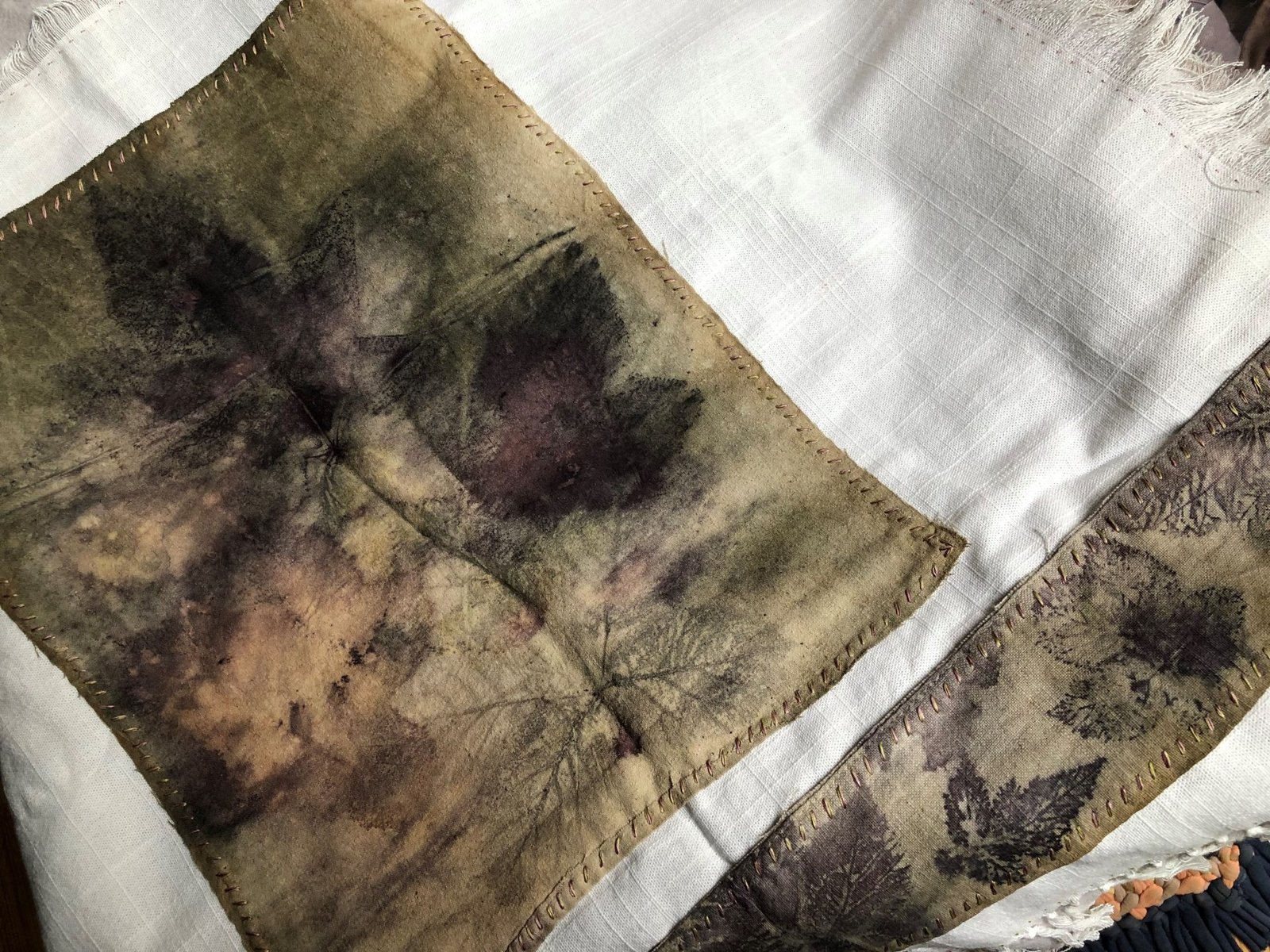The various talismans on display in the Land Dreams in Ceremonies: Reparation exhibit were created with awareness of and adherence to the “rules” and guidelines of traditional ceremonial crafting. Within the spirit of making sacred objects, I chose to also be true to the relationships the talismans were crafted for. That means that each talisman reflects: Ukrainian sacred knowledge and folklore; who I am as mixed-ancestry diaspora; and my direct relationship with the lands I have inhabited and been connected to on Vancouver Island.
The ceremonial crafts you see are formed with an understanding of history, tradition, elemental- and energy- healing, plant medicine, life- and seasonal-rites, and symbolism… Crafting requires technical skill applied within the “rules” or guidelines of ritual making and is an active conversation between crafter, Spirit(s), land, ancestors, and the one whom the piece is intended for. To work with wrong-intent or mood puts the maker at risk of disconnection from their guiding forces; misfortune; or more…
“i chose to also be true to the relationships the talismans were crafted for.“
In Ukrainian folk practice, many amulets and talisman are “temporary.” They are intended to do a job – often absorbing illness and negativity – and then are released. The method of release is determined by the job they perform and by the season of letting go. It is truly important to honour the gift of temporary medicine.
Each grouping of talismans on display include: a Motanka, Pysanka, and Rushnyk. Each grouping is accompanied by a collage depicting photos of the land the grouping was made for, along with stories of the ceremony, crafting experience, and lessons learned. Additionally, collages include images of “temporary” talismans that were gifted to the land in a personal reparation ceremony. Bones that have been written on using protection and fertility symbols hang from the bottom of each collage.
Materials for the exhibit are either upcycled, found, foraged, grown, or hand-made. These include: fabric, threads, string, yarn, cordage, wood, eggs, and plant materials for dyes. Dyes for Motanky and Pysanky are natural, from plant and food sources. Mordants and modifiers include soya milk, iron (rail-road nails), vinegar, salt, and an aluminum pot.

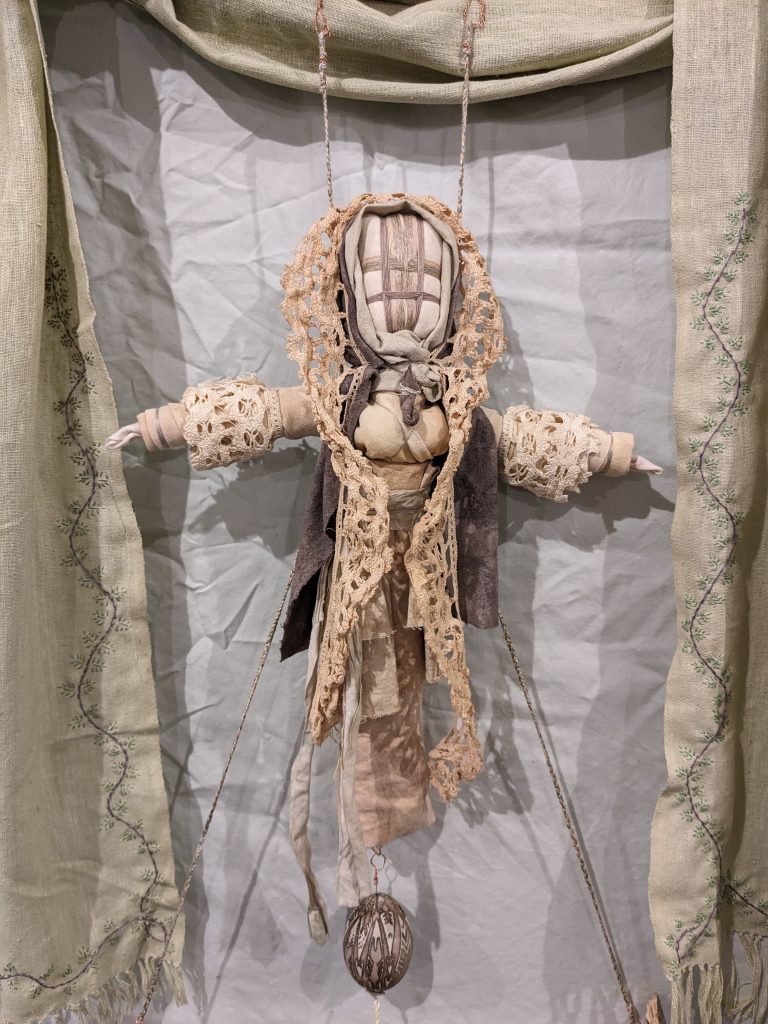
Motanka ~ a talismanic figure made of upcycled cloth; made in one sitting; faceless so as not to capture anyone’s spirit; made with “good mood” and uplifting prayers; bound “east to west” with string instead of sewn (no needle shall pierce its body) so as to retain good energy and prevent negative energy or spirits from entering; and an “x” on the chest to represent the Earth Mother. Each Motanka you see takes 4-6 hours to craft. The fabric takes several days to mordant and dye naturally.
Talismanic Motanky are crafted with prayers and intentions along with adherence to the above traditional “rules” of making. Giving one’s time, efforts, and resources, along with prayer and discipline, is an act of reciprocity – a “giving back/ giving forward” for all that Mati Zemlya (Mother Earth) provides.
Part of the “magical workings” of crafting is to make medicine from beginning to end in the span of one day, so that all effort, thought, and prayer are aligned and alchemized into precise potentized form. Each Motanka I craft is a same-day piece.
The Motanky you see on exhibit for each location are “fancy” – they were made in honour of the land and my experiences there and serve the purpose of connecting you (the witness) to something “felt” from that place when you view or interact with them.
Their facial wrappings are symbolic portals for ancestral wisdom. Their clothing is dyed with plants found on the land (example: blackberries), or plants that would have been used by my ancestors for both cloth and Pysanky (example: onions). “Temporary” Motanky (those released through either burying, burning, or floating in wild moving waters) generally do not include facial wrappings, though I did include a few Motanky with wrappings in my reparation work.
Pysanka ~ a talisman made from eggshell, written on using beeswax, dipped in natural dyes, and then heated to remove wax. The root word for Pysanka is pysaty – to write. Pysanky are “written,” not drawn. True talismans, which were used in the land reparation ceremonies, retain their contents. In this way, the egg – even before it is written upon – is a talisman containing a miniature sun floating in the waters of life. A fertilized egg laid on the first new moon of spring from a point-of-lay hen would be considered the most “potent” talisman. These are difficult to find! Pysanky for exhibit were made following same rules, and have contents removed in case they become compromised by temperature fluctuations or carelessness (contents would be rancid and quite smelly if the shells break or explode!). Each Pysanka takes 1-2 days to write, dye, remove wax, and oil.
An old tradition of burying a Pysanka in a field in spring brings protection and fertility to crops grown. A Pysanka would be gifted to a beehive for the same reason or buried at a new building site for its protection. Following traditions and protocol when burying medicine requires a trust that Mati Zemlya (Mother Earth) will envelop the medicine and absorb its prayers into the dark folds of Her being. Medicine is buried where no feet will walk upon it…
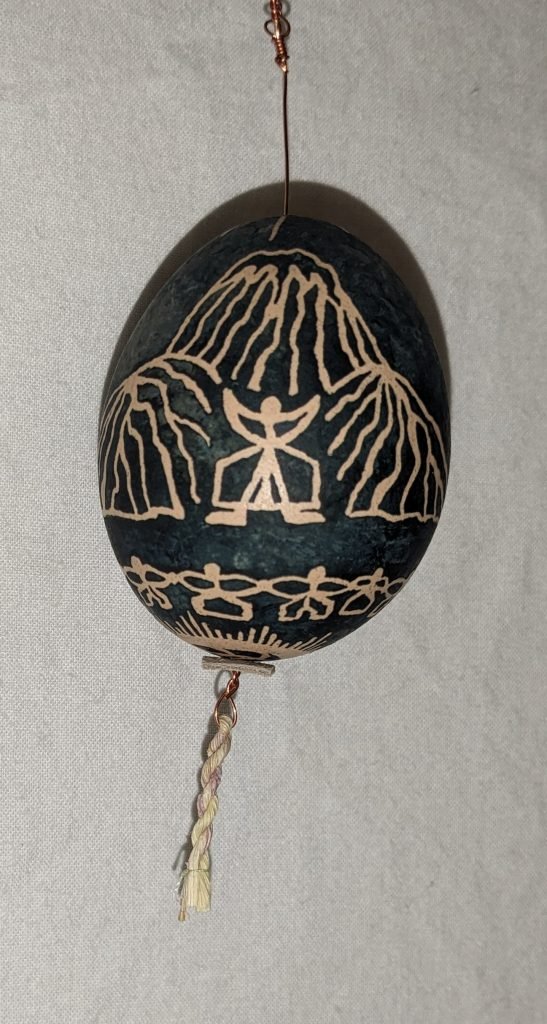

Rushnyk ~ a sacred talismanic cloth for use at one’s altar or sacred corner of the home; may accompany a person through all life-rites from birth to death; made from virgin cloth, the width of a loom (approximately 2 ft); linen, cotton or hemp; embroidered by hand with the same motif at each end; ends knotted with prayers; ends hanging toward earth to direct any negative energy toward her for transmutation. As I was working with upcycled fabric, I chose to return it to a “virgin” state by removing threads to make raw edges and then knot the ends. This process took hours for each length of cloth. Embroidered Rushnyky took weeks and months to complete. Eco-printed and dyed motifs took 3-4 days to complete.
One important olde healing ceremony involved crafting a same-day Rushnyk to help eradicate illness during epidemics. The makers would rise together in the wee morning hours, spin the threads, weave, embroider, and work in diligence to complete the Rushnyk. Once complete, everyone in the village passed under the Rushnyk, which was then burned ~ along with all the illness it gathered! I have read another account, from a different village, where the Rushnyk was laid upon the ground, and then “walked” end-over-end around the entire perimeter of the village to form a magical barrier against illness.
Each Rushnyk in this exhibit is my diasporic exploration of tradition meeting influences of the lands I live upon. Traditionally, the cloth is woven from linen (and in the past century, also cotton), embroidered by hand, with knotted ends that hang toward the earth (to direct any negativity toward Mati Zemlya, who is entrusted with transmuting those energies). It is considered “sacred cloth”. In my Baba’s practice of upcycling fabric during the wars and Depression, I have only used upcycled fabric for both Rushnyky and Motanky. Using upcycled fabric to craft with is both challenging and exciting – especially when precious pieces of linen, well-woven cotton, hemp, and silk find their way to my hands. Working with natural dye and fibre became an expression of ancestral memory and a growing expression of care for and responsibility toward the land.
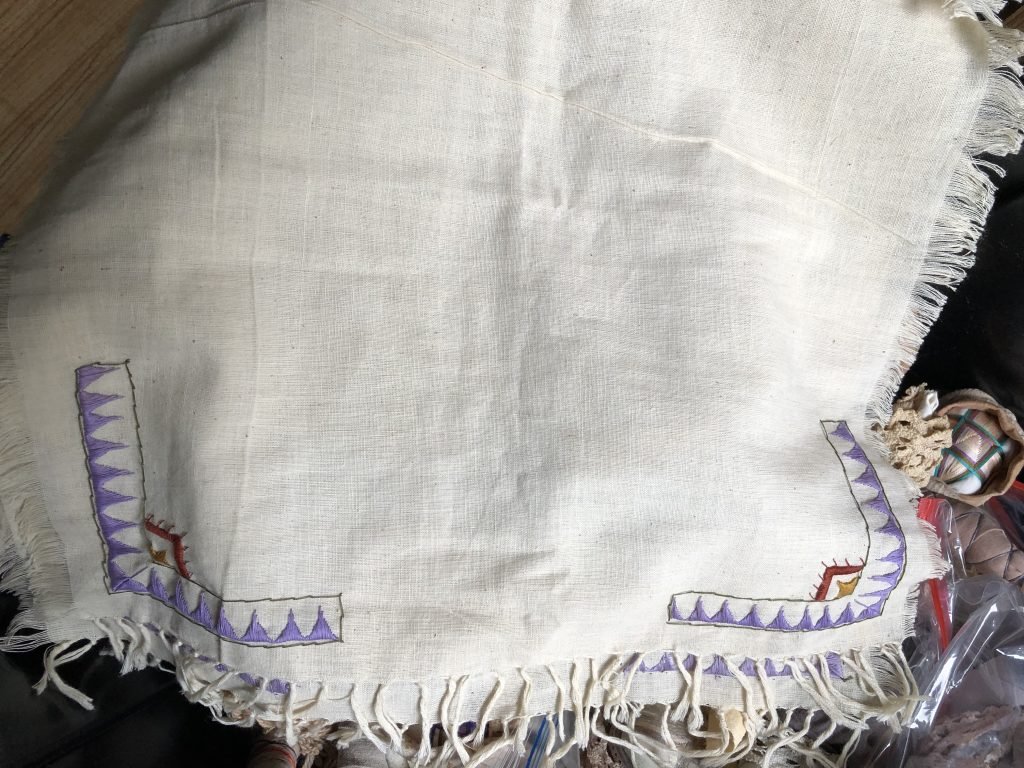
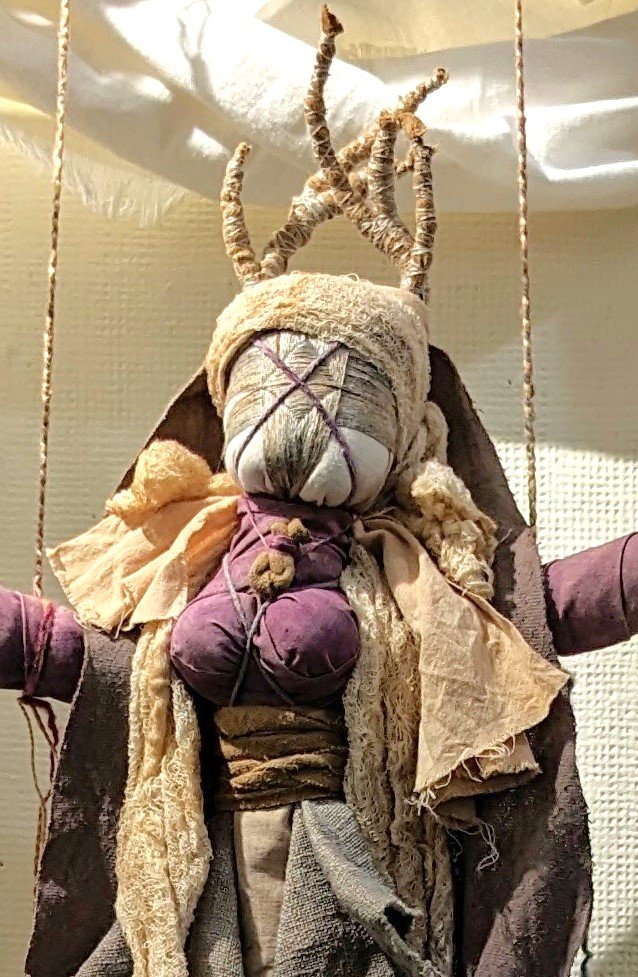
Sacred talismans such as Motanky, Pysanky, and Rushnyky are traditionally “given” rather than sold. It is thought that the act of gifting increases their “powers” as a talisman and selling them “devalues” these powers. Likewise, when performing rites, ceremony, sacred healing, and prayer work, these are not done for a fee… Visiting a Mol’farka, Baba, Babka, Sheptukha, Znakharka, Vorozhka, and any other number of wyse/ cunning/ magical women came with the understanding that one would leave a donation in exchange for their services and time.
Most folks these days do not carry that cultural understanding and practice. For that reason, I have chosen to suggest my ceremonial work & creations are available by donation. This approach requires, on my part, trust that the time, resources, and accumulated skill and knowledge will be received with care and understanding, and reciprocated in a way that will allow me, and the galleries that host the exhibits, to continue (and thrive) in this work. Ceremonial crafting is not about “picking and choosing” what is comfortable or easy. It is a genuine adherence to and integrity within a lifestyle that requires commitment to the practice, skills, spirits, and land.

